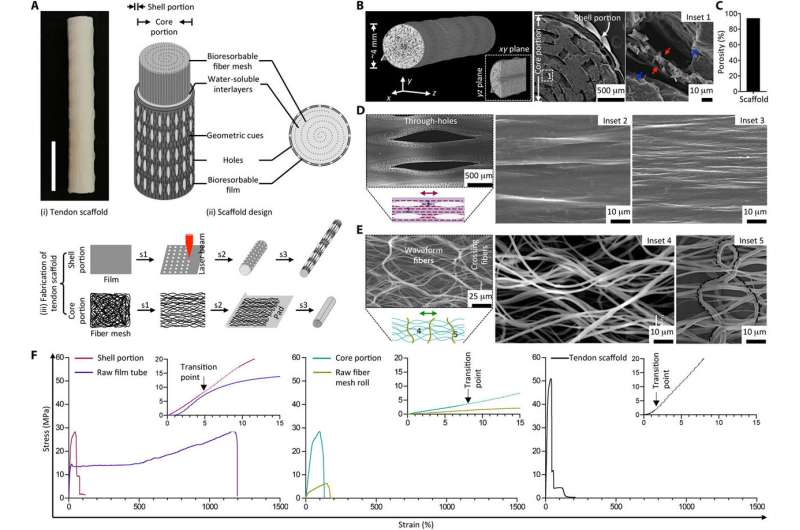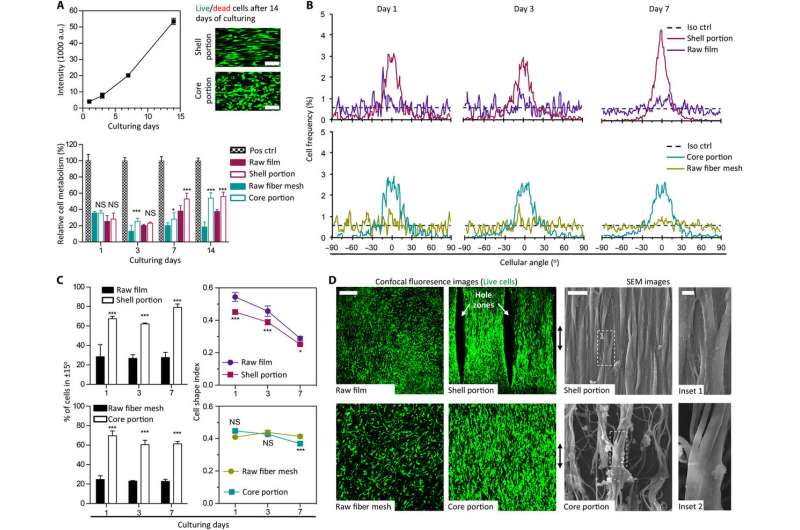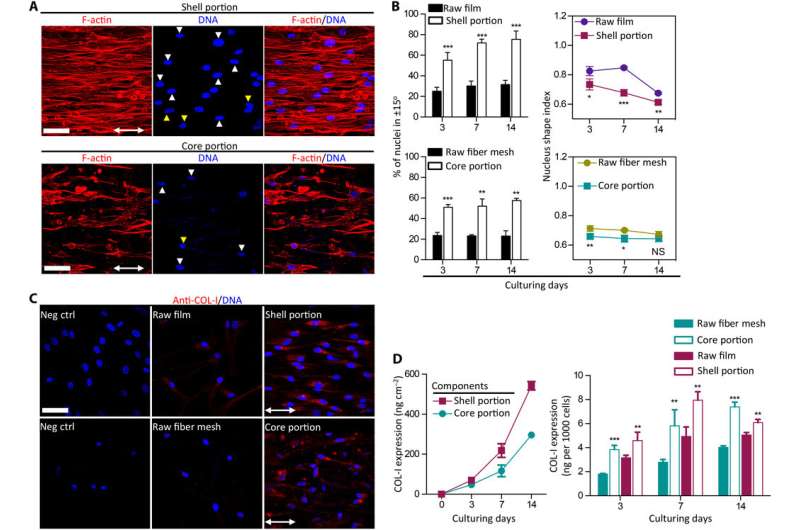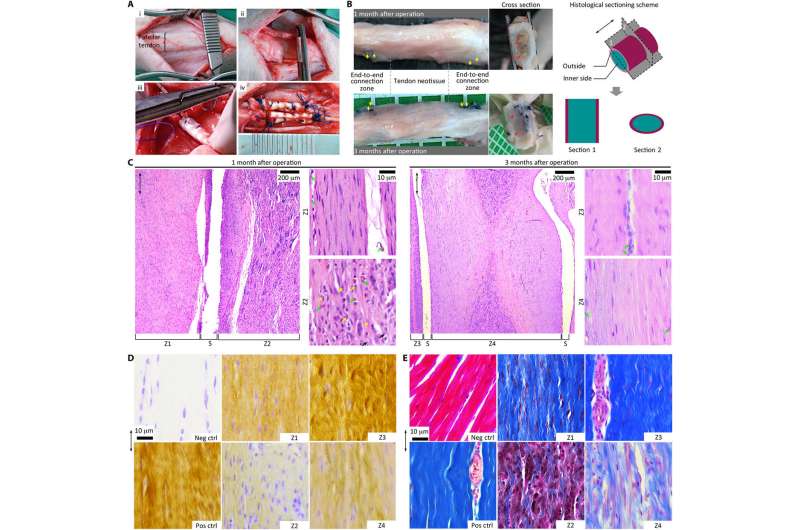The 3D scaffold architecture developed with controlled anisotropic microstructure and tendon-like mechanical properties. A) Gross appearance of the tendon scaffold designed with core/shell portions using bioresorbable multilayered PCL fiber meshes and films. B) Computed tomography (CT) three-dimensionally (3-D) reconstructed and scanning electron microscopy (SEM) cross-sectional images of the tendon scaffold. The images show a well-assembled multilaminar structure with a single film layer constituting the core portion. Red and blue arrows respectively represent the fiber and PEO interlayer. C) Calculated porosity of the tendon scaffold after dissolving PEO interlayers. D) SEM images of the shell portion showing elongated through-holes and oriented ridges/grooves in bulk regions. E) SEM images of the core portion that shows oriented waveform fibers. F) Representative stress-strain curves of the shell, core, and tendon scaffold to show reinforced material fabrication. The control groups for the scaffold shell and core portions included the raw film tube and fiber mesh roll. Credit: Science Advances, doi: 10.1126/sciadv.aat4537.
The underlying structure-function relationship of living tissues depends on structural and hierarchical anisotropy. Clinical exploitation of the interplay between cells and their immediate microenvironment has rarely used macroscale, three-dimensional (3-D) constructs. Biomechanical robustness is an important biomimetic factor that is compromised during biofabrication, limiting the relevance of such scaffolds in translational medicine.
In a recent study, Zu-Yong Wang and co-workers have detailed a polymeric three-dimensional scaffold engineered with tendon-like mechanical properties and controlled anisotropic microarchitectures. The construct is composed of two distinct portions for high porosity while retaining tendon-like mechanical properties. When tendon cells (tenocytes) were cultured on the scaffold in vitro, phenotypic markers of tenogenesis such as type-1 collagen, decorin, and tenascin were expressed more significantly than in non-anisotropic controls. Now published in Science Advances, the results demonstrated a highly aligned intracellular cytoskeletal network with high nuclear alignment efficiencies. The study also suggests that microstructural anisotropy may play the role of epigenetic mechanotransduction. The work further included an in vivo study where the biomaterial was implanted in a micropig model, with resulting neotissue formed on the scaffold to resemble native tendon tissue in both composition and structure.
The microenvironment in which living cells reside comprise an intricate niche of soluble biomolecules, cell-cell interactions and the extracellular matrix (ECM). In specialized tissues, the structural anisotropy and hierarchical organization of the ECM forms the stage for functions that range from soft (for neurons) to moderately stiff (skin, heart, blood vessel and muscles) to stiff (ligament, tendon and bone) tissues. These complex, yet well-defined macro-/micro- architectural attributes yield unique functions in these tissues. Biomimicry that recapitulates the structure-function relationship of tissues is therefore a goal for tissue engineering. Multiple studies have emphasized the importance of biomaterial design with specific microarchitectural structures directing tissue and cell aligned organization. Key principles of design include building topographies in the range of nanometers to engage focal adhesion or in the range of a few tenths of a micrometer to direct individual cells.
Interfacial cytocompatibility and morphological induction of human tenocytes on the tendon scaffold with anisotropic architecture. A) metabolic analysis and confocal images of human tenocytes that show proliferative cell growth without inducing cytotoxicity at the cell-material interface of the tendon scaffolds (green – live cells, red – dead cells). B) Representative cell angular frequency curves of human tenocytes during proliferation in the tendon scaffold, where they tend to organize in a preferred direction. C) Cell alignment and elongation analysis of human tenocytes described as a percent number of cells. D) Representative confocal fluorescent images and SEM images of human tenocytes after 14 days of culture to form cell bundles that align along the axial architecture of the tendon scaffold. Credit: Science Advances, doi: 10.1126/sciadv.aat4537
Altering the arrangement and fiber alignment of biomaterials and scaffolds have shown profound effects on cell shape, growth characteristics, migration and even cell fate. Many studies in materials science have used a variety of topographical geometries to achieve specific cell responses therefore. However, clinical translation of the well-established materials principles remains a significant challenge. Engineering highly precise and well-defined microarchitecture onto a biomaterial is complex and tedious. Scaffolds with desirable features are susceptible to surface and material disintegration during physical manipulation during implantation. Other complications include insufficient material porosity that prevents cell migration and blood supply in vivo.
At present, there is an unmet need to enable the translation of microarchitectural principles into clinical practice. This is highlighted during the repair of force-transmitting tissues such as tendons and ligaments. In such structures the biomechanical demands impose high mechanical robustness that most experimental scaffolds fail to meet. Most mechanical implants prioritize bulk material properties more so than microarchitectural intricacies to meet implant safety and feasibility in the clinic. In clinical orthopedics for instance, a rigid steel bone plate is favored to a porous scaffold biomaterial during complex fracture site stabilization to provide the comparatively higher mechanical robustness and strength, inherent to steel.
In the present study, Wang et al reported a tendon scaffold that integrates high strength, flexibility, and microtopographical features, while retaining the structure during tendon regeneration. The novel scaffold is composed of a core/shell structure, where the core portion contained a series of longitudinally aligned electrospun nanofibers arranged in a concentric multilayer. The shell portion was formed with a bioresorbable poly (ε-caprolactone) (PCL) film that first underwent laser perforation to create round through-holes. The films were rolled to meet each other and form a hollow tube via heat sealing. The core was prepared through cold axial drawing of an electrospun PCL mesh, followed by concentric rolling with a water-soluble polyethylene oxide (PEO) film.
Nucleus deformation and tenogenic matrix expression in the tendon scaffold. A) Representative confocal imaging of human tenocytes that show cytoskeleton organization and nuclear morphology. B) Nucleus alignment and elongation analysis of human tenocytes is described as percent number of nuclei and nucleus shape index (NSI). Cells cultured in the core and shell have higher cell alignment than in the controls. C) Representative confocal microscopy images of human tenocytes expressing elevated collagen type I in the tendon scaffold shell and core. D) Quantitative measurement of COL-I that shows lasting secretion for human tenocytes in the tendon scaffold, at up-regulated levels than controls. Credit: Science Advances, doi: 10.1126/sciadv.aat4537.
The scaffolds were characterized with scanning electron microscopy (SEM) and computed tomography (CT) to investigate morphology. Mechanical characterization was conducted thereafter to investigate if the scaffolds exhibited similar modulus and biomechanical behavior to native tendons. To assess the influence of the polymer's geometric features on tenogenesis stimulation, adult human tenocytes were seeded on both portions individually and in the assembled constructs for in vitro evaluation. The scaffolds offered the cells a conductive microenvironment for proliferation, demonstrating sustained metabolic increase after 2 weeks of cell culture. The core/shell portion of the scaffold provided physical anisotropy to mimic a tendon's ECM. Confocal microscopy images revealed live cell populations that were migrating to the core.
Reconstruction of tendon neotissue. A) Establishment of a tendon injury model. B) Gross appearance of neotendon tissue construct harvested 1-3 months after operation. C) Histological images of neotendon construct after H&E to show gradual neotissue formation. D) Immunohistological images of neotendon construct showing progressive collagen matrix deposition. E) Histological staining with Masson’s trichrome to demonstrate fibrous structure formation. Credit: Science Advances, doi: 10.1126/sciadv.aat4537.
Geometric features of polymer scaffolds were proposed to deliver epigenetic cues via mechanotransduction. Certain configurations of the cell resulted in combined cytoskeletal and nuclear alterations that regulated the activity of specific cellular genes. Tenocytes stained for actin and DNA revealed the organized arrangement of cytoskeletal actin filaments via confocal imaging on the scaffold's shell and core. The results suggested that cytoskeletal and nuclear alignments upregulated COL-1; a major protein forming the tendon matrix for mature tendon functions. According to the study, the physical anisotropy of geometric features in the biomaterial activated tenogenic pathways.
After completing in vitro tests, the authors used the scaffold in a preclinical setting to evaluate the macrostructural design of the microporous construct in a micropig injury model in vivo. Implants were harvested after three months, and the tissue sample extracted for histological analysis. The authors used Hematoxylin and Eosin (H&E) to observe organized neotissue in the construct. The cells and partial neotissue developed in an organized alignment, directed by the scaffold architecture. Immunohistochemistry analyses of the neotissue demonstrated collagen deposition, corresponding to the different phases of healing after implantation. The histological Masson's trichrome stain showed fibrous structure formation of the deposited collagen at different stages of maturity.
The authors demonstrated the potential to use tissue engineering techniques to create macro-sized scaffolds suited for tendon repair. The geometric features on the polymer delivered physical cues for ordered tissue regeneration, with potential application to construct tissue-specific architecture and advance regenerative therapies in soft tissue repair.
More information: Z. Wang et al. Functional regeneration of tendons using scaffolds with physical anisotropy engineered via microarchitectural manipulation, Science Advances (2018). DOI: 10.1126/sciadv.aat4537
Samir Mitragotri et al. Physical approaches to biomaterial design, Nature Materials (2008). DOI: 10.1038/nmat2344
Journal information: Science Advances , Nature Materials
© 2018 Science X Network



























